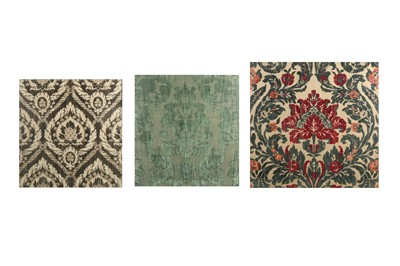2nd Dec, 2020 14:00
A Middle Eastern Journey | Live Online
THREE SILK VELVET BROCADE PANELS
Possibly Genoa, Italy, 17th - 18th century
THREE SILK VELVET BROCADE PANELS
Possibly Genoa, Italy, 17th - 18th century
Comprising a dark green and grey silk velvet panel, brocaded, decorated with a diamond-shaped grid filled with a central stylised lotus flower surrounded by clovers and a leafy vegetal crown, the motif inspired from Ottoman voided silk velvet Catma panels, mounted, stretched, glazed and framed, 68cm x 65.5cm including the frame; a light green brocade panel, with a lush, fully-bloomed rosette in the centre, flanked by vine trellis, foliage and fruits, mounted, stretched, glazed and framed, 68cm x 65.5cm including the frame; and a red, green and orange brocade panel on cream ground, with a central stylised lotus flower, surrounded by a vegetal and floral crown, mounted, stretched, glazed and framed, with an old German framer sticker Paul Kirchhoff Koeln Muelheim, 63cm x 64.5cm including the frame.
The history of silk fabrics and their European productions has been interwoven with prestige, status and luxury since its early days, dating back to at least 1311 AD, when one of the earliest written European references to silk velvet is referring to items owned by Pope Clement V (r. 1305-1314), including two lengths of red velvet from the north Italian city of Lucca. Since the early 12th century, this town, near Pisa, had been a major producer of silk textiles of various kinds. The creation of a patterned silk textile, including brocade and damask, required a skilled weaver and a considerable investment in equipment and raw materials, limiting its production to only a few major specialised centres in Europe.
The Italian city-states of Florence, Venise, Milan and Genoa triumphed as the main producers of luxury silks throughout the Middle Ages and the Renaissance, and continued to dominate the production of luxury textiles well into the 17th century. Made with silk purchased from exotic lands, such as Iran and Syria (which purchased it from China), the Italian manufactures became so sought after and prestigious that it wasn't long before the very countries from which they purchased the raw materials, started commissioning and importing back Italian creations, including the Ottomans.
During the 15th and 16th centuries, Venice and Florence were praised for their sumptuous velvets incorporating gold and silver threads with large floral patterns. Genoa caught up shortly after, in the 17th century, building a reputation for polychrome floral velvets with large-scale patterns primarily intended for wall covering and furniture (Watt, Melinda. “Textile Production in Europe: Silk, 1600–1800.” In Heilbrunn Timeline of Art History. New York: The Metropolitan Museum of Art, 2000–. http://www.metmuseum.org/toah/hd/txt_s/hd_txt_s.htm, 2003). A number of Italian silk damask and brocaded panels is now part of major art museum's collections, such as the Metropolitan Museum of Art (MET), the Cleveland Museum, and the V&A in London, shedding light on the entwined connections of trade and textiles in the Renaissance and post-Renaissance centuries.
Sold for £812
Includes Buyer's Premium
Do you have an item similar to the item above? If so please click the link below to submit a free online valuation request through our website.


